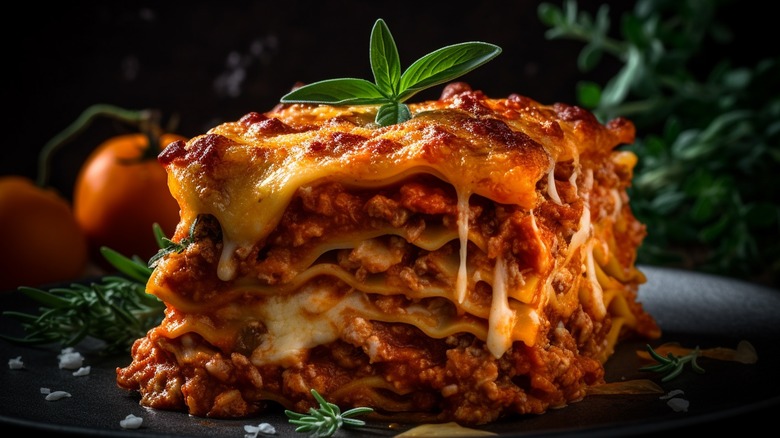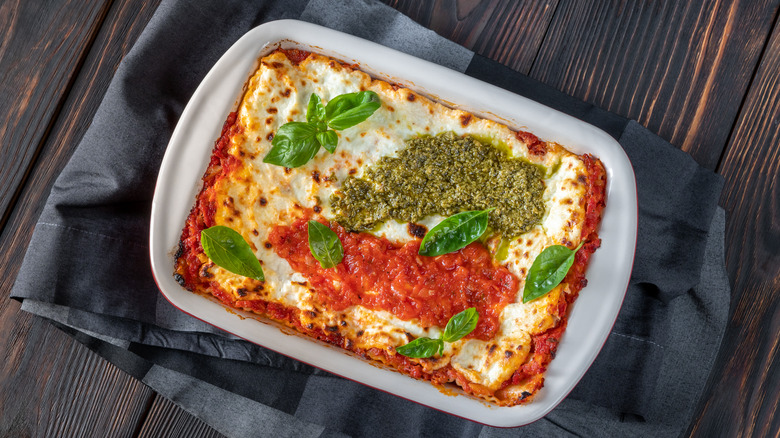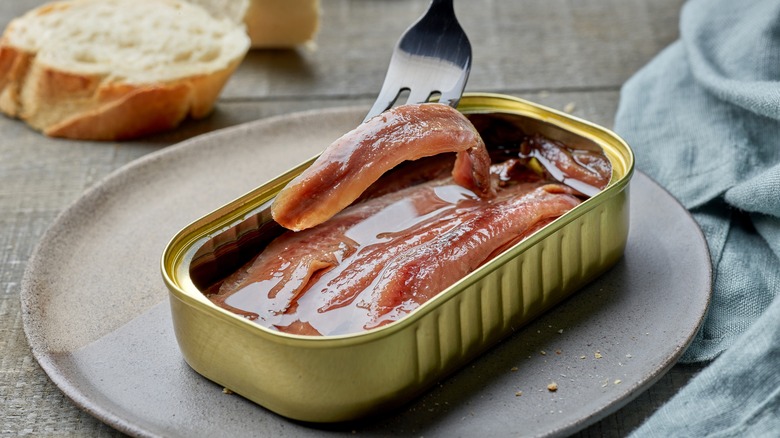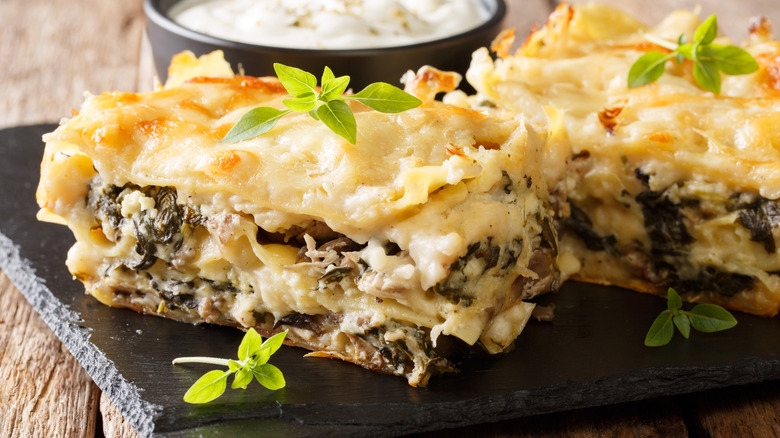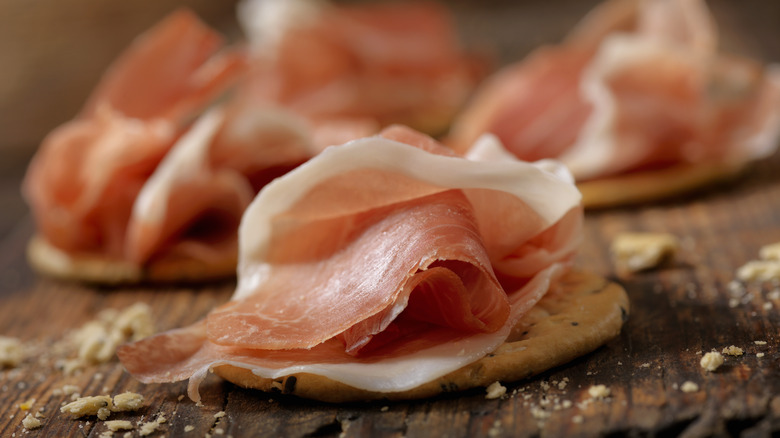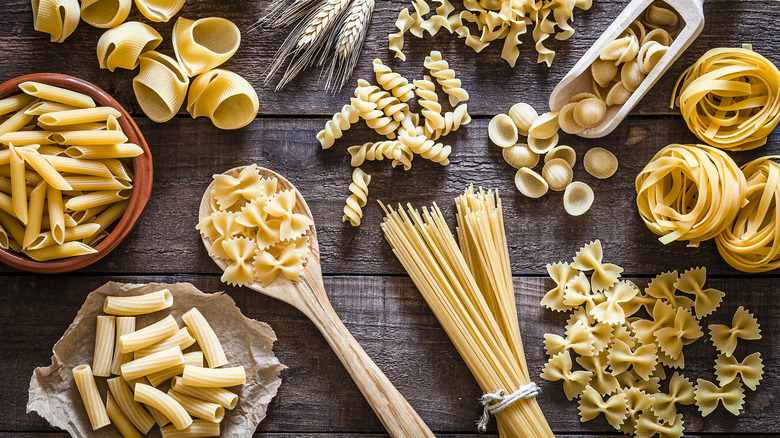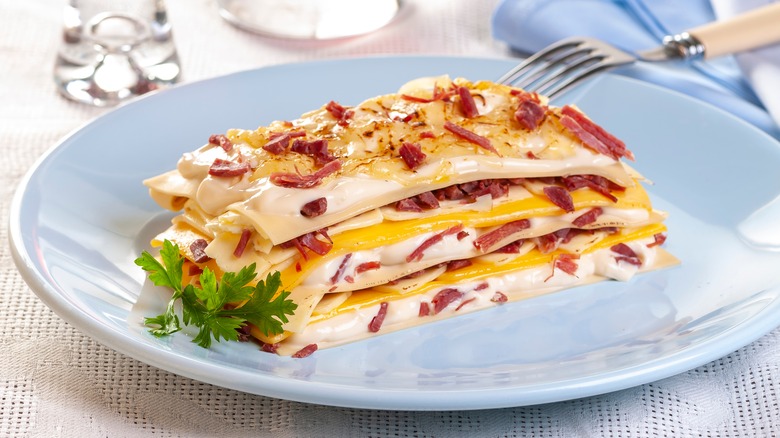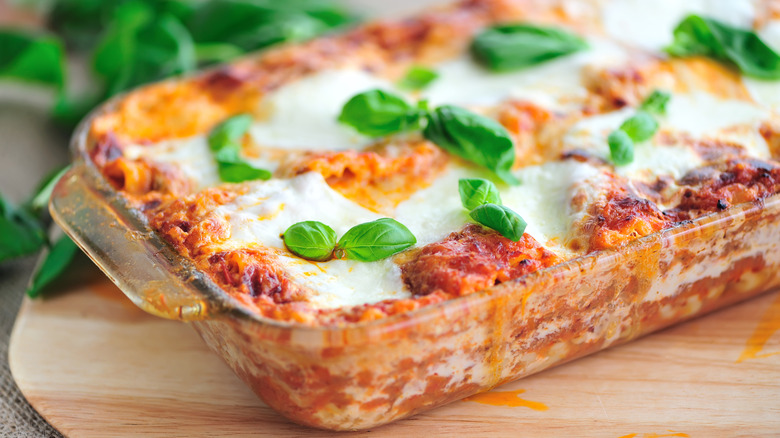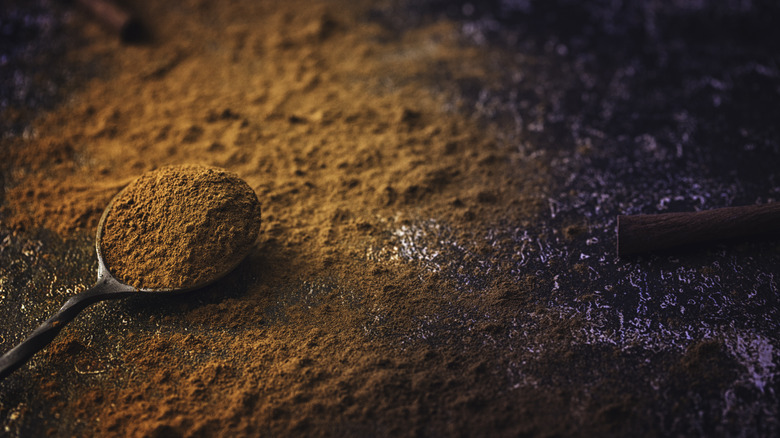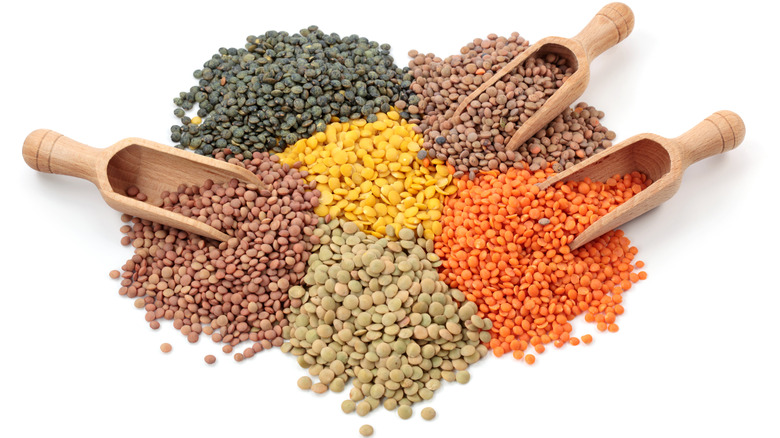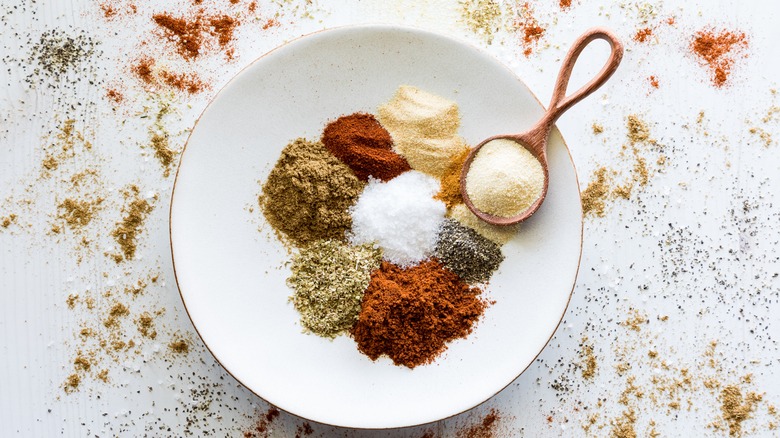13 Ways To Upgrade Lasagna You Probably Never Thought Of
Lasagna may come from Italian tradition, but it has long crossed the borders, and we can freely say that we are talking about the dish that many regions adopted and adapted into their culinary canon. The classic lasagna is a well-familiar affair: Stacks of thin lasagna sheets are intertwined with flavor-packed meat sauce topped with gooey layers of melted cheese. An extra touch of a crunchy top crust serves as the perfect antidote to the sloppy, tender center. Cutting into it, you do not expect to see a neatly assembled, technically precise casserole; you want the cheese to stretch and the meat to ooze out. Lasagna is not picture-perfect, but flavor-wise, it is one of the most incredible options for a comforting meal.
Though lasagna is flawless in its original form, sometimes even perfection can be amplified. In this case, we are talking about ingredients that will take your lasagna to the next level and diversify your cooking repertoire. We hate to admit it when it comes to lasagna, but sometimes, change is good, and these unconventional upgrades might make you fall in love with lasagna all over again. Some add complexity, depth, and flavor, while others amp up the creaminess and nutrition levels. Every item on the list is easily available for convenient application. Now, let's find your next favorite lasagna upgrade and get creative.
1. Layer the lasagna with basil pesto
Basil is a popular Italian ingredient, but it is not something you usually see inside lasagna. However, this aromatic herb can seriously upgrade your lasagna game by providing a whiff of herbal aromas and a zingy flavor that will help to break through all the fatty layers.
Classic pesto was invented in Genoa. In the most traditional form, it combines heaps of fresh basil pounded with pine nuts, Parmigiano Reggiano, garlic, and streams of olive oil until it becomes a thick paste that you can then easily add to pasta, spread on bread, or use in any way imaginable. Classic basil pesto is the first choice for lasagna, but don't miss out on other variations. Zesty arugula-based pesto would also help balance savoriness and heavy flavors, but variations that use spinach or parsley would also blend in nicely and provide that sharp element that lasagna can benefit from.
If you are layering pesto, you should use just a tiny amount and spread it across the sauce. Pesto is quite intense, and a little goes a long way. To add just a hint of herbal aromas, you can add the pesto as a finishing touch on top of the dish. If you can't be bothered with the homemade version, jarred pesto is perfectly acceptable for lasagna.
2. Swap out the lasagna sheets for ravioli
Ravioli are something that you will certainly never see associated with classic lasagna. This idea most likely stemmed from the kitchens of Italian Americans, but despite the total disharmony with tradition, using ravioli instead of plain pasta sheets might be the most ingenious lasagna twist.
The process is simple: Switch your regular lasagna pasta for your favorite stuffed ravioli. You can use fresh or frozen kinds, which can be used as is or cooked beforehand. Both options should work; just layer them evenly so there is minimal overlapping.
With many ravioli varieties, you'll have to choose the one that will work with the other ingredients in the dish. The safest option is always the cheese-stuffed ravioli, which are typically filled with ricotta. They are neutral enough to work with most lasagna recipes, but they offer a fun, cheesy surprise when you cut into the lasagna. You can exercise creativity with the selection of pasta fillings. Choose mushroom-stuffed ravioli for an aromatic umami kick, increase the creaminess with pumpkin or potato ravioli, or go for the meat-stuffed pasta pockets for the carnivores.
You don't have to restrict yourself to ravioli, as there are many other stuffed pastas to choose from. Though, make sure the pieces are thin and suitable for layering. Even the culinary queen Ina Garten recommends this combination, so you can be sure it works perfectly.
3. Create the lasagna sauce with anchovies
Anchovies are small but pack a ton of flavor. As they are preserved in salt or oil to have a long shelf life, they are so intensely flavored that one jar can go a long way. Anchovies are a great way to kick up the flavor of any dish and are not reserved only for seafood specialties. You can use them whole to add more character to pizza or neatly stack them on bruschetta. As they are soft and tender, they easily turn into a paste that you can later blend into stocks, sauces, or even soups. This crushed, paste-like version is also suitable for lasagna. Anchovies will masterfully elevate it with a distinctive umami-like flavor.
The use of anchovies can be seen in lasagna puttanesca. The moniker puttanesca refers to the eponymous sauce that blends garlic, olives, oil, red pepper flakes, capers, tomatoes, parsley, and anchovies into a mix that oozes southern Italian flair. The sauce can be used as the regular red sauce in lasagna and would pair nicely with milder ricotta. If you don't want to make puttanesca for your lasagna, you can choose any sauce of your liking and add a pinch of anchovies. They are even great added to the classic white sauce. Just be careful to adjust the amount of salt, as these tiny kitchen heroes are quite salty.
4. Integrate mushrooms into the lasagna sauce
Mushrooms are ubiquitous in home kitchens, but we rarely think of adding them to lasagna, though they can be easily incorporated for incredible depth of flavor. They are convenient if you're whipping up meat-free lasagna, as they can mimic the meaty texture. Mushrooms also perform well in the flavor department, as they pack powerful earthy and savory nuances that blend into umami-like richness.
If you want a hint of that earthy sweetness, add mushrooms straight into the meat sauce and stew until they are well integrated. However, if you're going for the meat-free route, it's best to turn the mushrooms into a rich mushroom ragù by sautéing them with onions and spices. You can tweak it with tomatoes to resemble the classic meat sauce. Mushrooms go well with béchamel or ricotta sauce, but you can also leave them out as the mushrooms will provide enough creaminess. They are also a suitable partner with strong-flavored cheese, which usually goes inside or on top of lasagna, so feel free to play around and create a version that suits your taste. There are no restrictions when it comes to the selection of the mushrooms. Use regular button or cremini mushrooms, or go for full-flavored porcini or chanterelles. You can even use different types of mushrooms together.
5. Add prosciutto to the lasagna
Prosciutto is one of the most prized Italian products. This cured ham is an irreplaceable ingredient in Italian cuisine, and you'll usually see it stacked on top of pizza or inside sandwiches, but perhaps the best way is to serve paper-thin slices as antipasti and pair them with some crusty bread and olives, all washed down with good wine. Though it's a perfect ingredient in its original form, prosciutto boasts an incredible medley of savory, sweet, and nutty flavors that would translate well into a creamy and hearty lasagna.
When talking about prosciutto, it's crucial to highlight that the word can refer to prosciutto crudo, which is the intensely-flavored cured version, and prosciutto cotto — regular cooked ham. For lasagna, you'd want to go with the cured crudo variety. You can add prosciutto directly to your lasagna, but don't go overboard — even a small amount of prosciutto will bring a lot of savory nuances.
6. Incorporate squash into the lasagna
We mostly limit squash to soups and pies, even though it has the potential to do more in the kitchen. Zucchini, a summer squash with soft, edible skin and flesh, tends to get more love. You'll often see it fried and grilled, but it generally feels as if we should let this versatile fruit show off more. For starters, start incorporating it into lasagna and other similar casseroles.
Squash can easily add more character to your original lasagna recipe. Sweeter varieties will lend satisfying sweetness and hearty richness, while the younger ones impart a lighter herbaceous element. For sweet winter varieties, it's best to roast the whole squash, scoop up the creamy mash, season, and incorporate it as one of the lasagna layers. Summer squashes that are more juicy and tender can be fried and used as one of the layers, but they are also great as a nutritious addition to the meat ragù. As squash tends to soften when cooked, it can be an excellent choice to replace the pasta with zucchini. Just slice them thinly and layer them with other elements. Not only will squash provide texture to your lasagna, but it will also give a wonderful boost of flavor and add fruits to your meal.
7. Use other pasta varieties instead of lasagna sheets
There's nothing wrong with the pasta sheets traditionally used in lasagnas. They are easy to work with — the no-boil versions are especially practical as they do not call for additional prep work — and are made explicitly for lasagna, so they do the job perfectly. However, why not spice it up with other types of pasta? Most are suitable for lasagna or any other casserole dish. Penne, rigatoni, or fusilli would be terrific options. Surprisingly, even thin pasta like spaghetti can be used for lasagna, but you'll get a really distinctive texture with thin pasta threads.
Always cook the pasta beforehand, but leave it al dente, as it will have time to soften when nestled among the sauces. You can stack pasta to get more height and an extra chewy lasagna. This suggestion to swap out the pasta can also be useful if you run out of lasagna sheets. The chances of you having at least one other box of pasta lying around are high, so there is no reason to skip or postpone making a gooey lasagna.
8. Throw in some bacon
It seems that bacon is always the go-to ingredient that instantly makes food better and more flavorful. Unsurprisingly, the same applies to lasagna. Adding bacon to lasagna is not unheard of, but it's not a common ingredient you will usually see listed in lasagna recipes. The easiest way to implement bacon is to fry bits of it until they are nice and crispy and then sprinkle it on top of each layer. This technique will enhance the flavor and add a pleasant textural component, with crispy bits in each bite. Another way is to dice the bacon and incorporate it into the ragù or tomato sauce. Bacon will infuse the sauce with a faint smoky note, evenly distributed throughout the dish.
For the ultimate bacon overload, wrap the whole lasagna in bacon, just like you would with meatloaf. Assemble bacon slices on the bottom of the baking dish, with the tops hanging out on the sides, and then layer the lasagna as usual. When your lasagna is assembled, throw the hanging bacon slices over the top. You will end up with a package-like lasagna creation with a thin and crunchy bacon coating. The bacon will crisp up and lend some of its flavor and fatty juices to your lasagna.
9. Put spinach on the recipe
Spinach is not used in Italian lasagna-making tradition, but adding this ingredient to lasagna is not totally alien. The vegetable is a familiar partner to pasta and cheese, so a spinach lasagna sounds about right.
The easiest way to include spinach is to combine it with ricotta. The two commonly appear together, making a wonderful blend of tangy and earthy notes. You can mix the ricotta with some wilted, sautéed, or cooked spinach. If you're working with a recipe that does not list ricotta, chop your spinach and sprinkle it onto each lasagna layer. In both cases, make sure you drain the spinach well. You don't want a watery mess inside your lasagna. Besides classic lasagna, spinach also goes well in the meat-free version. It has enough character to act as a single ingredient, but it is also flexible when partnered with other vegetables, especially artichokes, zucchini, or peppers. Spinach will give your lasagna a pleasing taste, and don't forget that it's also a nutritional powerhouse that is welcomed in our diets, according to Healthline.
10. Choose goat cheese for the dairy component
Though cheese is one of the essential parts of every lasagna, it should only act as a supporting character and not the dominating element. The cheese selection is usually of classic sorts and relies on tried and tested favorites. In most cases, traditional lasagna will feature Parmigiano Reggiano and mozzarella, but cheddar and other types of aged cheese are also common, as well as the light and tangy ricotta. On the other hand, goat cheese is an unexpected and unconventional option, but it can be a real game-changer for lasagna.
Goat cheese varies in texture and flavor depending on the style and age. Though there are subtle differences, you want something with more character for the lasagna. As this is such a strongly flavored and potent dish, the tangy and zesty note of goat cheese should be noticeable and cut through all the fat and meaty richness. Aged goat cheese would get that effect. If you're aiming for a milder flavor, use fresh goat cheese — you'll often see it labeled as chèvre.
11. Bring out the flavors with cinnamon
Cinnamon fits right into the category of the most unusual ingredients you'd ever consider adding to lasagna. This warm, sweet spice is something we typically associate with cakes and cookies, but cinnamon delivers the same warmth and depth to savory dishes. Though we often classify it as potent and robust, cinnamon can be wonderfully subtle when used in the right amount, adding just a hint of sweet spiciness that rounds out the whole profile.
Cinnamon forms a strong team with meat, especially in fat-laden stews and ragùs, which means that it would be an ideal addition to the classic lasagna meat sauce. The distinctively warm characteristic of cinnamon matches the savory notes, juicy meat, and tartness of the tomato sauce. Like salt, it helps bring out the best in every element. Apart from the ragù, you can even mix in a spoonful of the spice to the ricotta if it's on your list of ingredients.
12. Infuse lentils into the lasagna
Lentils often don't get the credit they deserve. These tiny legumes come in many colors and can jazz up soups, stews, casseroles, or salads. They make creamy hummus-like spreads and perfectly thickened sauces. Besides their versatility, lentils are an excellent protein source and are genuinely budget-friendly. In lasagna, they can be a great meat alternative but also help you build a more wholesome and nutrition-dense dish, according to Healthline.
If you want to incorporate lentils into lasagna, the optimal way is to cook them together with the meat sauce. Red lentils are ideal as they cook quickly and instantly turn into a soft and creamy base that blends with the color of the sauce. If you want to make vegan lentil lasagna, use lentils and cook them down with a generous amount of seasoning, tomatoes, spices, and other vegetables to build a sauce that delivers a medley of flavors and textures. For this version, use brown or green lentils, which have much more substance and will retain some chew.
13. Sprinkle in some taco seasoning
Taco seasoning is a spice blend intended to deliver traditional Mexican flavors. The ingredients inside these blends vary, but chili and paprika are usually the foundations, while onion powder, cumin, and salt are some common elements that help diversify the flavor with more complex and nuanced expressions. Taco seasoning is convenient and a great all-rounder that you can sprinkle on top of tacos and guacamole or incorporate into chili and hearty stews. It would work with any recipe that calls for ground meat, including lasagna.
Though mixing Italian and Mexican flavors is totally unexpected, the combination is almost foolproof. The best way to incorporate it is to blend it into the meat ragù. The seasoning will deliver a delectably warm smokiness and subtle spiciness that will marry well with the cheese and the tomatoes. If you want the flavors to pop, sprinkle each layer with seasoning and let it shine through with each bite. If the recipe includes ricotta, a spoonful of taco seasoning will help to balance heavy creaminess and tartness. Another inspiring idea is to lightly dust the top of the lasagna before baking to get a crunchy, spiced crust.
